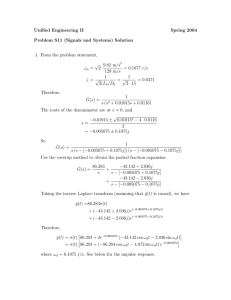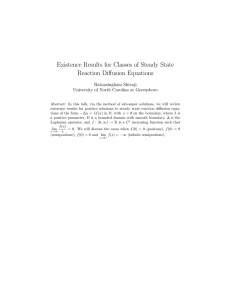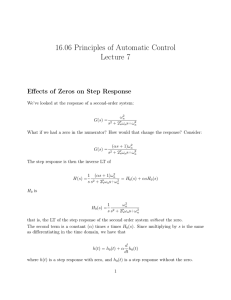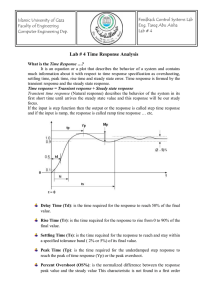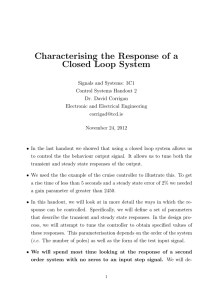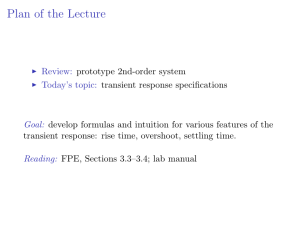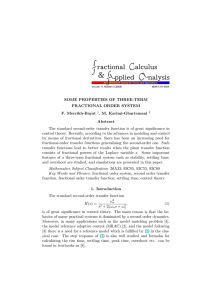Time Response of First & Second Order Systems
advertisement
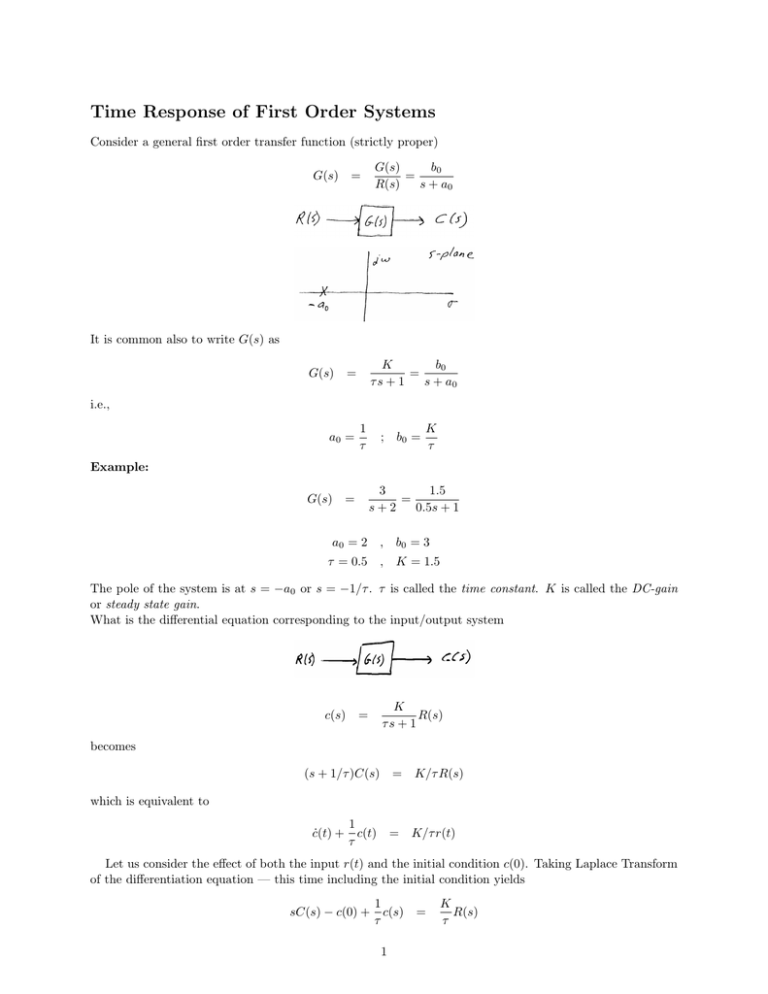
Time Response of First Order Systems Consider a general first order transfer function (strictly proper) G(s) G(s) b0 = R(s) s + a0 = It is common also to write G(s) as G(s) b0 K = τs + 1 s + a0 = i.e., a0 = 1 τ ; b0 = K τ Example: G(s) 1.5 3 = s+2 0.5s + 1 = a0 = 2 , τ = 0.5 , b0 = 3 K = 1.5 The pole of the system is at s = −a0 or s = −1/τ . τ is called the time constant. K is called the DC-gain or steady state gain. What is the differential equation corresponding to the input/output system c(s) K R(s) τs + 1 = becomes (s + 1/τ )C(s) = K/τ R(s) 1 c(t) τ = K/τ r(t) which is equivalent to ċ(t) + Let us consider the effect of both the input r(t) and the initial condition c(0). Taking Laplace Transform of the differentiation equation — this time including the initial condition yields sC(s) − c(0) + 1 c(s) τ 1 = K R(s) τ or c(s) = K/τ c(0) + R(s). s + 1/τ s + 1/τ Note that the initial condition could be represented in the differential equation by an input c(0)δ(t) where δ is the unit impulse function ċ(t) + 1 c(t) τ K r(t) + c(0)δ? τ = In block diagram from we have By superposition the response of the system is the sum of the response due to the initial condition alone (the free response) and the response due to the input R(s) (the forced response). If R(s) = u(t), the unit step function, then the force response (step response) is given (with zero condition) as c(s) = k/τ 1 K K · = − . s + 1/τ s s s + 1/τ In the time domain c(t) = K(1 − e−t/τ )u(t) If the response continued to increase at its initial rate it would reach its steady state value K after τ -seconds. We see that the forced response is composed of two terms −Ke−t/τ called the transient response and K called the steady state response. 2 Then slope of c(t) at t = 0 is d c(t) dt t=0 K −t/τ K = e τ τ t=0 = To say it another way the transient response would decay to zero after τ -seconds. In practice we say that the system reaches about 63% (1 − e−1 = .37) after one time constant and has reached steady state after four time constants. Example: G(s) 5 s+2 2.5 0.5s + 1 = = The time constant τ = 0.5 and the steady state value to a unit step input is 2.5. The classification of system response into – forced response – free response and – transient response – steady state response is not limited to first order systems but applies to transfer functions G(s) of any order. The DC-gain of any transfer function is defined as G(0) and is the steady state value of the system to a unit step input, provided that the system has a steady state value. This follows from the final value theorem lim c(t) t→∞ = lim sC(s) = lim sG(s)R(s) s→0 s→0 = G(0) if R(s) = 1/s provided sC(s) has no poles in the right half plane. Second Order SystemsConsider a second order transfer function G(s) = c(s) b0 = 2 . R(s) s + a1 s + a0 The standard form of this transfer function is G(s) = K· s2 3 ωn2 + 2ζωn s + ωn2 omegan = ωn is called the natural frequency (or undamped natural frequency). zeta = ζ is called the damping ratio. The characteristic equation is s2 + 2ζωn s + ωn2 = 0 which has roots p 4ζ 2 ωn2 − 4ωn2 2 p = −ζωn ± ωn ζ 2 − 1 s = −2ζωn ± We consider 3 cases 0<ζ<1 ζ=1 ζ>1 1) if 0 < ζ < 1 the system is called underdamped. The roots are complex conjugate p s = −ζωn ± jωn 1 − ζ 2 The unit step response is c(s) = G(s)R(s) = ωn2 s(s2 + 2ζωn s + ωn2 ) and it can be shown that c(t) 1− = 1 −ζωn t e sin(βωn t + θ) β where β = p θ = tan−1 (β/ζ) 1 − ζ2 τ = 1/ζωn is the time constant of the exponentially decaying term. c(t) ≈ 1 after 4τ . 4 smaller ζ = more oscillation = more overshoot = longer time to reach steady state ζ = 0 is undamped and the oscillations never decay to zero. underdamped second-order step response – decaying oscillation – overshoot – constant steady state 2) ζ = 1 is called critically damped. In this case √ s2 − 1 = 0 and the roots are real and repeated s = −ωn 3) ζ > 1 is called overdamped. The roots are real and distinct p s = −ζωn ± ωn ζ 2 − 1 s1 = s2 = p ζ2 − 1 p ζωn + ωn ζ 2 − 1 ζωn − ωn In both the overdamped and critically damped cases the step response does not oscillate 5 overshoot rise time settling time steady state error are all measures of performance that are used to design control systems. percent overshoot Mpt − Css Css × 100 rise time Tr is the time required for the step response to rise from 10% to 90% of its final value. The Settling Time Ts is the time required for the response to remain within a certain percent of its final value, typically 2% to 5%. If we use 4 time constants as a measure then τs = 4τ = 4/ζωn These specifications can be used to design ξ, ω. Calculation of percent overshoot. Since the step response (for ζ < 1) is given by c(t) = 1− 1 −ζωn t e sin(βωτ + θ) β = 0 ⇒ sin(βωn t) = 0 the maximum value Mpt can be found from d c(t) dt Therefore the maximum occurs at time Tp where βωn Tp = π or Tp = π p ωn 1 − ζ 2 The peak value M( pt) is calculated from C(Tp ) = = 1 −ζω nt e sin(βωn t + σ) β t=T1 √ −ζπ/ 1−ζ 2 . 1=e 1− Therefore the percent overshoot is P.O. = √ 2 e−ζπ/ 1−ζ × 100 6 and depends only on ζ. The graph can be used for design. Example:Suppose you want M < 20%. Then you must design the system so that ζ > 0.5 (approx) Example: Suppose M , K are given. How should you choose B (shock absorber) so that the P.O. to a unit step is less than ∼ 4%. Example: M = 100 K = 1000 100ẍ + B ẋ + 1600x = f B ẋ + 16x = 100 1 f 100 or ẍ + The characteristic polynomial is S2 + B S + 16 100 = S 2 + 2ζωn S + ωn2 . Therefore we want P.O. ¡ 4%, therefore (from the graph) ζ > 0.7 with ζ = 0.7, ωn = 4 we see that B = 2 · 0.7 · 4 100 Therefore B = 560 nt · sec M Note that Tp is also an indication of rise time. From Tp = π p ωn 1 − ζ 2 7 we have ωn Tp π = p 1 − ζ2 . Relation to Pole Location Since the poles at s = −ζωn ± jωn p 1 − ζ2 We see that the real part determines the settling time (recall Ts = 4/ζωn ) p α = −1 tan 1 − ζ2 = cos−1 ζ ζ Therefore P.O. = √ 2 e−ζπ/ 1−ζ × 100 α = e−π/ tan × 100 Example:Suppose we want P.O. < 4.32% (which corresponds to ζ = Ts < 2. Then form Ts = 2 ζωn √1 2 ≈ 0.707) and a settling time 6 < 2 we get ζωn > 2 or −ζωn < −2 and we have α cos−1 (0.707) = 45% 8

